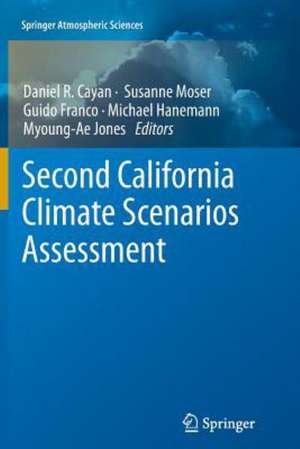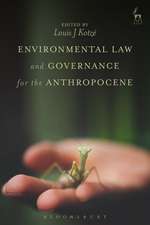California Climate Scenarios Assessment: Springer Atmospheric Sciences
Editat de Daniel R. Cayan, Susanne Moser, Guido Franco, Michael Hanemann, Myoung-Ae Jonesen Limba Engleză Paperback – 20 sep 2014
Reprinted from Climatic Change, Vol. 109: Supplement 1 (2011)
| Toate formatele și edițiile | Preț | Express |
|---|---|---|
| Paperback (1) | 1229.40 lei 43-57 zile | |
| SPRINGER NETHERLANDS – 20 sep 2014 | 1229.40 lei 43-57 zile | |
| Hardback (1) | 1244.71 lei 43-57 zile | |
| SPRINGER NETHERLANDS – 26 aug 2012 | 1244.71 lei 43-57 zile |
Din seria Springer Atmospheric Sciences
- 24%
 Preț: 814.30 lei
Preț: 814.30 lei - 18%
 Preț: 891.33 lei
Preț: 891.33 lei - 15%
 Preț: 649.39 lei
Preț: 649.39 lei - 18%
 Preț: 956.81 lei
Preț: 956.81 lei - 18%
 Preț: 1133.13 lei
Preț: 1133.13 lei - 23%
 Preț: 732.59 lei
Preț: 732.59 lei - 23%
 Preț: 679.90 lei
Preț: 679.90 lei - 18%
 Preț: 732.07 lei
Preț: 732.07 lei - 20%
 Preț: 765.26 lei
Preț: 765.26 lei - 18%
 Preț: 747.83 lei
Preț: 747.83 lei - 24%
 Preț: 804.87 lei
Preț: 804.87 lei - 15%
 Preț: 637.28 lei
Preț: 637.28 lei - 24%
 Preț: 1594.86 lei
Preț: 1594.86 lei - 18%
 Preț: 966.27 lei
Preț: 966.27 lei -
 Preț: 429.66 lei
Preț: 429.66 lei - 15%
 Preț: 468.90 lei
Preț: 468.90 lei - 18%
 Preț: 784.79 lei
Preț: 784.79 lei - 18%
 Preț: 956.03 lei
Preț: 956.03 lei - 24%
 Preț: 826.78 lei
Preț: 826.78 lei - 18%
 Preț: 1398.31 lei
Preț: 1398.31 lei - 18%
 Preț: 1692.84 lei
Preț: 1692.84 lei - 18%
 Preț: 1006.72 lei
Preț: 1006.72 lei - 15%
 Preț: 643.34 lei
Preț: 643.34 lei - 24%
 Preț: 831.85 lei
Preț: 831.85 lei - 15%
 Preț: 534.50 lei
Preț: 534.50 lei - 15%
 Preț: 639.90 lei
Preț: 639.90 lei - 24%
 Preț: 816.12 lei
Preț: 816.12 lei - 24%
 Preț: 1564.10 lei
Preț: 1564.10 lei - 15%
 Preț: 638.57 lei
Preț: 638.57 lei
Preț: 1229.40 lei
Preț vechi: 1499.27 lei
-18% Nou
Puncte Express: 1844
Preț estimativ în valută:
235.32€ • 255.70$ • 197.80£
235.32€ • 255.70$ • 197.80£
Carte tipărită la comandă
Livrare economică 21 aprilie-05 mai
Preluare comenzi: 021 569.72.76
Specificații
ISBN-13: 9789400791985
ISBN-10: 9400791984
Pagini: 564
Ilustrații: X, 554 p.
Dimensiuni: 155 x 235 x 30 mm
Greutate: 0.78 kg
Ediția:2013
Editura: SPRINGER NETHERLANDS
Colecția Springer
Seria Springer Atmospheric Sciences
Locul publicării:Dordrecht, Netherlands
ISBN-10: 9400791984
Pagini: 564
Ilustrații: X, 554 p.
Dimensiuni: 155 x 235 x 30 mm
Greutate: 0.78 kg
Ediția:2013
Editura: SPRINGER NETHERLANDS
Colecția Springer
Seria Springer Atmospheric Sciences
Locul publicării:Dordrecht, Netherlands
Public țintă
ResearchCuprins
From the Contents: Overview of the California climate change scenarios project.- Linking climate change science with policy in California.- Climate change scenarios for the California region.- Identification of external influences on temperatures in California.- Climate change projections of sea level extremes along the California coast.- Adaptability and adaptations of California’s water supply system to dry climate warming.- Progress on incorporating climate change into management of California’s water resources.- Robust analysis of future climate change impacts on water for agriculture and other sectors: a case study in the Sacramento Valley.
Notă biografică
Dr. Daniel R. Cayan is a Research Meteorologist at the Scripps Institution of Oceanography (SIO), University of California, San Diego, and is also a Researcher at the U.S. Geological Survey. His work is aimed at understanding climate variability and changes over the Pacific Ocean and North America. Specific interests concern impacts of climate changes on water resources and other sectors in western North America.
Cayan heads the California Nevada Applications Program and the California Climate Change Center, climate research programs to improve climate information and forecasts for decision makers in the California region.
Cayan received a BS degree in Meteorology and Oceanography in 1971 from the University of Michigan. He received a Ph.D. in Oceanography in 1990 from the University of California, San Diego. He has been employed by Scripps since 1977 and by the U. S. Geological Survey Water Resources Division since 1991.
Cayan heads the California Nevada Applications Program and the California Climate Change Center, climate research programs to improve climate information and forecasts for decision makers in the California region.
Cayan received a BS degree in Meteorology and Oceanography in 1971 from the University of Michigan. He received a Ph.D. in Oceanography in 1990 from the University of California, San Diego. He has been employed by Scripps since 1977 and by the U. S. Geological Survey Water Resources Division since 1991.
Textul de pe ultima copertă
In response to Executive Order S-3-05, an evaluation of the implications to California of possible climate changes was undertaken using a scenario-based approach. The “Scenarios Project” investigated projected impacts of climate change on six sectors in the California region. The investigation considered the early, middle and later portions of the twenty-first century, guided by a set of IPCC Fourth Assessment global climate model runs forced by higher and lower greenhouse gas emission scenarios. Each of these climate simulations produce substantial impacts in California that would require adaptations from present practices or status. The most severe impacts could be avoided, however, if emissions can be held near the lower end of global greenhouse gas emissions scenarios.
Reprinted from Climatic Change, Vol. 109: Supplement 1 (2011)
Reprinted from Climatic Change, Vol. 109: Supplement 1 (2011)
Caracteristici
Provides a fascinating glimpse into the possible ecological futures of one of America's most well-known states The research for this books takes in various views on environmental threats: climate warming, wildfire, forest growth, sea levels, air quality etc Offers clear government and policy actions and points towards future reaearch directions












